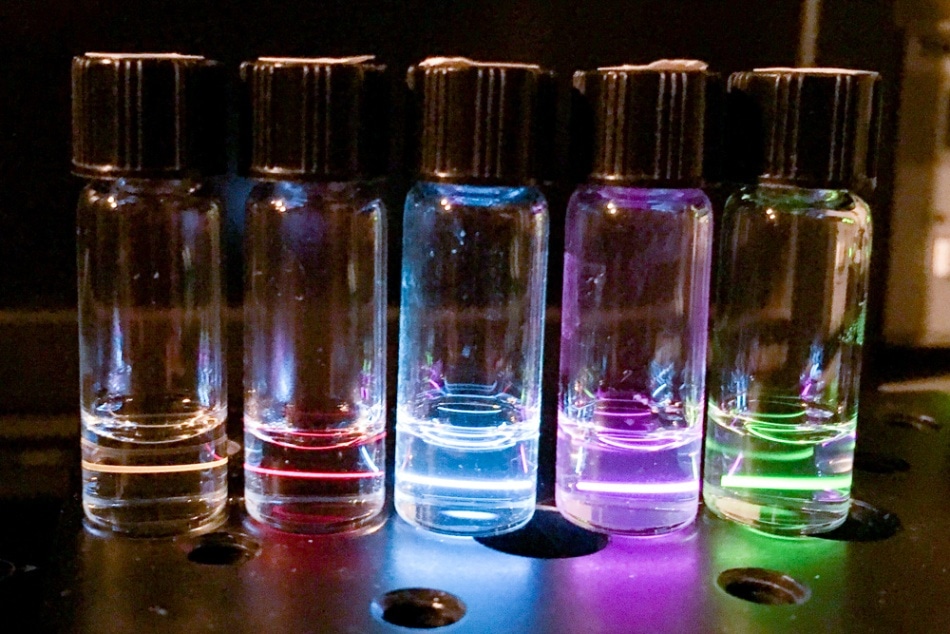Jan 3 2017
 In the Dionne lab at Stanford, a laser causes nanoparticles suspended in cyclohexane to emit light. The nanoparticles change color depending on the pressure around them and give real-time information about the forces they undergo. (Image credit: Alice Lay)
In the Dionne lab at Stanford, a laser causes nanoparticles suspended in cyclohexane to emit light. The nanoparticles change color depending on the pressure around them and give real-time information about the forces they undergo. (Image credit: Alice Lay)
Worms that are a millimeter-long and capable of digesting a nanoparticle-laced meal of their favorite bacteria could help to develop a way to see the working of cellular forces within human bodies and also in processes like cancer growth and wound healing.
When struck by a near-infrared laser, these specific nanoparticles glow and change color based on the pressure surrounding them. So, they can release real-time information about the forces they are undergoing while continuing to be inside the worm.
Altered cellular-level forces underlie many disorders, including heart disease and cancer. This would be a nanoscale readout that you could use in vitro or in vivo to detect disease at a very early stage.
Jennifer Dionne, Associate Professor, Stanford University
Dionne has collaborated with Miriam B. Goodman, a professor of molecular and cellular physiology, through a Stanford. Bio-X seed grant, which is specifically awarded to encourage such interdisciplinary partnerships. Goodman analyzes the touch sensation mechanics in Caenorhabditis elegans, the worms dining on Dionne’s nanoparticles.
Watching Worms Digest
The ultimate goal of the research is to detect force in human cells, but the team is testing its approach in these worms, that are hardly visible, because as in humans, digestion in worms involves mechanical gnashing and shoving that can provide insight into how cellular force is registered by these nanoparticles.
The color that each nanoparticle emits changes from red to orange when there is a mechanical force on the order of nanonewtons to micronewtons – a force range thought to be very relevant for intercellular forces.
Alice Lay, Graduate Student, Stanford University
Mutations will be introduced by the team into the mix in order to determine the role of gene expression on cellular forces. This introduction will take place only after the researchers complete their analysis of healthy worms. These mutations will help the researchers to enhance their understanding of digestive and related disorders, and also acid reflux and hernia formation.
From Worm Food to Human Health
This work could influence how individuals study and understand human touch, cellular division and differentiation, wound healing, cancer, digestion, and much more.
Mechanical forces play a significant role in determining the fate and function of a cell or of an organ. For example, every time our heart beats, our ears hear or a wound heals, cellular forces are involved.
Jennifer Dionne, Associate Professor, Stanford University
These nanoparticles have the potential to develop extremely high-resolution force maps due to their tiny size, providing a window into the push and pull of and by cells on a deeply subcellular level. It is believed that someday these biocompatible nanoparticles will be ingested or injected into an individual in a particular area, such as at a suspected tumor or wound site. Labs will be able to develop a force map indicating the fine-scale activity of the cells surrounding that area by reading the colors emitted by the nanoparticles.
Adding to Goodman’s earlier research on how neurons process the sensation of touch, this method could also improve the understanding of the forces involved in sensing the world around us. “More detail about how we experience touch could inform the translation of touch into non-biological systems, like prosthetics,” Goodman said.
So far, Dionne’s lab has developed the nanoparticles, the high-tech snack has been successfully eaten by Goodman’s worms and static images of the nanoparticles present inside the worms have been taken by the researchers. The researchers next focus is on capturing the dynamic emission of the nanoparticles over time, which indeed will disclose the changes in force the particles experience during digestion.
Dionne is also a member of Stanford Bio-X, an affiliate of the Precourt Institute for Energy and a member of the Stanford Neurosciences Institute. Goodman is also a member of Stanford Bio-X and the Stanford Neurosciences Institute.